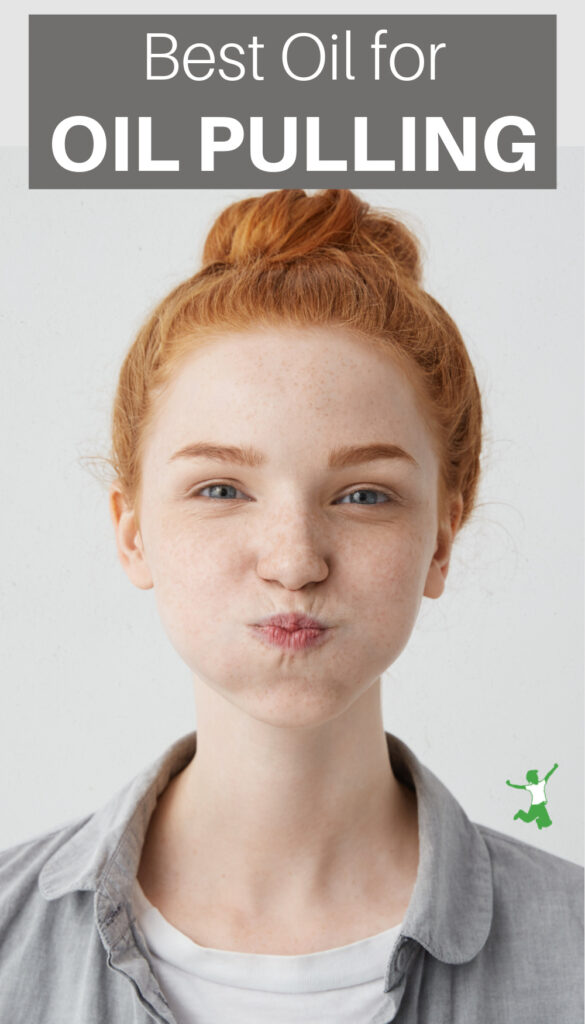The best oils to use for oil pulling for optimal benefits to oral health by eliminating toxins and pathogens from the gateway microbiome.

I first learned about oil pulling two decades ago while studying Ayurvedic cooking.
“Pulling” is an ancient detoxification therapy mentioned in ancient Ayurvedic texts and is recommended as an easy, daily practice.
Over time, “oil gargling” or “swishing” can drastically improve oral health and help resolve many chronic conditions such as periodontal (gum) disease and cavities. (1)
It can also be helpful for acute illness.
For example, oil pulling therapy has been touted as a strep throat remedy and helps resolve persistent sore throat issues.
Oil Pulling Health Benefits
The modern resurgence of this ancestral practice started in 1992 and was initiated by Dr. F. Karach, MD, who used it with great success in his medical practice.
Dr. Karach claimed that oil pulling would resolve a variety of illnesses including hormonal problems, cardiovascular disease, and digestive ailments. (2)
Dr. Bruce Fife, author of Coconut Cures and Oil Pulling Therapy: Detoxifying and Healing the Body Through Oral Cleansing, suggests that oil pulling therapy can effectively be used to clear and heal sinus problems. (3)
In fact, this is one of the first detox symptoms that are experienced is an increased flow/clearing of mucus from the throat and sinuses.
Mucous drainage is one of the body’s best methods of removing toxins.
How Does “Pulling” Work?
The practice of oil pulling is extremely simple.
Simply swish one tablespoon of raw, cold-pressed oil in the mouth for 15-20 minutes.
The swishing process involves gently pushing and pulling the oil around and through the teeth.
Try to oil pull at least once and up to three times per day on an empty stomach.
If you only do it once per day, the best time is first thing in the morning before breakfast or drinking anything. However, if you forget, any time of day before eating will do if necessary.
Dr. Fife advises the following while oil pulling:
While you are pulling, mucous may build in the back of your throat. You may even have to expel the oil and clear the mucous from your throat before reaching a full 20 minutes. That’s okay, take another spoonful of oil and continue until you’ve pulled for a total of 15-20 minutes. (4)
After swishing with the oil for the allotted amount of time, the oil is completely spat out and the teeth, gums, tongue, and palate are gently cleaned by rinsing the mouth with saltwater and brushing as usual.
Feel free to use a bit of sole water for this purpose if you have some on hand.
This next point may seem obvious, but it bears mentioning. It is important to never swallow or otherwise reuse the oil.
I think it is best to spit it out into the toilet rather than the sink because it contains toxins and bacteria and possibly even pus and mucous if an infection is present.
Which Oil is Best?
A variety of oils work very well for oil pulling.
Traditionally, unrefined sesame oil, coconut oil, or butter oil (ghee) were used.
The modern-day practice of this ancient therapy includes extra virgin olive oil or unrefined sunflower oil as alternatives as well.
While any one of these oils is likely effective, is any particular choice better than the others?
According to research performed by Irish scientists from the Athlone Institute of Technology who tested the effects of coconut oil, vegetable oil, and olive oil on dental health, the answer is yes.
Of the three types of oil tested, only coconut oil prevented tooth enamel damage by the pathogen Streptococcus mutans.
This acid-producing bacterium is a common inhabitant of the mouth and a major cause of tooth decay. (5)
This latest finding lends serious credibility to anecdotal claims that oil pulling works best with coconut oil.
Lead researcher Dr. Damien Brady stated that coconut oil could prove to be an attractive alternative to chemicals in maintaining oral health. (6)
He noted that not only does coconut oil work at relatively low concentrations but with the worrisome problem of increasing antibiotic resistance, it is important to consider coconut oil as a potentially novel new way to control microbial infections.
Dr. Fife also recommends making medicated coconut oil to enhance the effects and healing properties of oil pulling. (7)
Refined vs Unrefined
Virgin coconut oil (VCO) is the best choice for oil pulling therapy as it is truly “raw”.
This type of coconut oil is completely unheated with micronutrients and co-factors not present in refined versions. It is ideal for medicinal use.
Remember too, that coconut oil solidifies at 76 °F/24 °C, so if your virgin coconut oil is solid in the pantry, you may need to gently liquefy it in a pan of warm water first.
However, this step is not necessary if you are comfortable letting it melt in your mouth before you start swishing.
If you wish to supercharge the process, you can use ozonated coconut oil, which further enhances the anti-bacterial and anti-plaque benefits of oil pulling.
This therapeutic form of coconut oil is great for holistic dental flossing too and a practice recommended by biological dentists.
Bonus! Virgin coconut oil is an excellent oral antifungal as well.
Is Oil Pulling Right for You?
Oil pulling is probably the cheapest and easiest oral detoxification regimen you could ever try.
It simply involves swishing your mouth with unrefined oil one to three times a day on an empty stomach and then spitting it out.
No dieting, fasting, herbs, or pills are required to get started.
No matter what your age or level of health, oil pulling is harmless and nearly anyone can do it.
Sometimes powerful answers come in a brown paper bag.
Give oil pulling with virgin coconut oil a try!

(1) A review of holistic approaches to oral health
(2) Oil Pulling Therapy by Dr. Karach: Russian Folk Remedy
(3, 4, 7) Oil Pulling Therapy: Detoxifying and Healing the Body Through Oral Cleansing
(5, 6) Coconut oil can combat tooth decay, study suggests








I also stopped oil pulling due to metal fillings. Have you seen any info on that?
Christy Zubke is this what you we’re speaking of????
..
6 months ago my gums were a mess, and I just had a perfect check up! This worked! Can’t wait to see if it affects my spring allergies too!
Tricia O’Leary
The best oil for AYURVEDIC therapy is the one used in AYURVEDA – PERIOD. Sesame or sunflower. It is an utter irony that west has “admitted” the power of an ancient terapy and STILL had to modify it.
Right on!!!
I had no idea I was doing this. Just added this regimen a month ago. Wanted to get rid of mucous that accumulated in my chest while I slept. My lungs are badly scared. Was rinsing my mouth and teeth with salt and Oreganol oil and clumps of thick viscous mucous would accumulate at the back of my throat and the roof of my mouth. I had to use a tooth brush to scrape it out. Instinctively, I knew to throw the brush away. I couldn’t Blv how much better my breathing got. I haven’t had to use my nebulizer regularly since trying this. I will definitely try the coconut oil and add a little Oreganol to see the results. Thanks
BTW: I do my Nettie pot an hour afterwards. This deals with the sinus issues I have with pollen, dust and mild spores. I suffer from Aspergilloma.
I found out that Neem Oil works really good for oil pulling and has many other uses. What I do is that I mix 2tsp of Coconut Oil and 1tsp of Neem Oil to which I then add few drops of 3 different essential oils Cinnamon Leaf, Clove Bud and Oregano. I also add 50mg of Coq10 per Tsp of Coconut/Neem oil.
At times I vary the essential oils using Peppermint, Lavender and others and also do the mixture without the Coq10, without the Neem and so on, just to have different variations, nutrients and health benefits mixed with my oil pulling.
So far it works wonder and my relatives loves it as well.
freqvency, timing, length of oil pulline? what problems you had and what got better/cured?
I do it at least once per day but normally 3 times daily.
My aim is 30 minutes oil pulling but aim to do it for at least 20 minutes, anything after that is just extra time.
Sinus, a minor infection, very high sensitivity to heat and cold liquids, pain when flossing and sometimes bleeding (in the past.)
– Great improvement on the sensitivity.
– Amazing improvement on the pain when flossing.
– 100% recovery from the bleeding.
– Progress with the infection but still not out. I do have to mention that sometimes I drink and even smoke and that is one reason (in my opinion) why the infection hasn’t gone away.
So here is my regimen simplified.
1 – 3x Oil pulling daily for at least 20 minutes
2 – Virgin Coconut Oil, Neem Oil, Coq10 and Essential Oils.
I also have a tone scraper.
I drink water first thing in the morning at room temperature.
I floss at night and brush my teeth twice a day.
Every time after eating anything, I make sure to remove any left over by washing or even slight brushing.
From time to time, I do baking soda toothpaste, mouthwash with H202 (Hydrogen Peroxide), a cool mix of baking soda and apple cider vinegar and then spit it out.
Last but not least, add clove, cinnamon or oregano oil to floss. This can literally burn your lips but done once a week it really helps.
I do all this because I had endless problems with my teeth and going to the dentist wasn’t an option. I had to be there. Now I enjoy not going and my mouth health is getting better by the day.
Hope that helps
Can you pull while pregnant or nursing? I have read conflicting things. Anyone have experience? Thanks!
Carie Dittrich a few answers to our oil pulling questions.